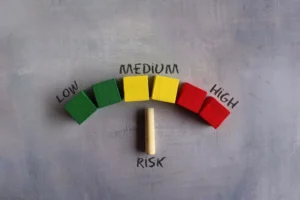In the world of trading, volatility is both a threat and an opportunity. If you want to trade with more confidence and fewer surprises, learning how to read and manage volatility is essential. One of the most effective tools for this purpose is the ATR Indicator. Known as the Average True Range, the ATR is a straightforward volatility indicator that helps you gauge market movement, set logical stops, refine position sizing, and manage risk at a professional level. In this comprehensive guide, you’ll learn what the ATR is, how it works, and most importantly, how to use it to achieve better trading results in real markets.
Understanding Volatility: The Role of ATR
Markets never move in straight lines. Prices rise and fall, sometimes quietly and sometimes with explosive force. Volatility describes these price changes, measuring how much a market moves within a given period. For traders, volatility determines how much they can potentially gain—or lose—on any given trade.
The ATR Indicator gives you an objective way to measure this volatility. Developed by J. Welles Wilder Jr., the ATR was originally designed for commodities but now finds use across all assets, including stocks, forex, and crypto. Unlike many other technical tools, the ATR does not tell you which way prices will move. Instead, it simply reveals how much they are likely to move, which is crucial for anyone wanting to trade smarter and control risk.
If you’re trading EURUSD and see an ATR value of 90 pips, you know the average daily range is 90 pips. A small ATR value means the market is quiet. A high value signals increased activity and higher potential risk. By incorporating ATR into your trading routine, you can make decisions based on current market conditions rather than guesses or emotion.
How to Calculate the Average True Range
The ATR is surprisingly simple to calculate, but its impact on your trading is profound. Here’s a step-by-step look at how it’s determined:
- For each trading day, identify the following three values:
- Today’s high minus today’s low.
- The absolute value of today’s high minus yesterday’s close.
- The absolute value of today’s low minus yesterday’s close.
- Choose the largest of these three numbers as the “true range” for the day.
- Average the true ranges over a set number of periods, usually 14.
This rolling average becomes your ATR line on the chart. You’ll notice that after major news events or market shocks, the ATR often rises sharply, showing the spike in volatility. In contrast, during periods of consolidation or sideways movement, the ATR tends to decline.
You don’t need to do these calculations manually—every trading platform displays the ATR with a simple click. But understanding how it’s built will help you use it wisely in your own strategies.
Why the ATR Is the Preferred Volatility Indicator
With so many indicators available, why do so many professionals rely on the ATR? The answer lies in its objectivity, clarity, and universal application.
Unlike Bollinger Bands, which combine volatility and direction, or standard deviation, which only measures dispersion, the ATR stands alone as a pure volatility measure. It tells you nothing about bullish or bearish trends—just how much the market has been moving. This simplicity makes it incredibly flexible.
For example, in the forex market, many pairs experience sharp moves around central bank announcements. By watching how the ATR behaves during these times, you can prepare for bigger price swings and protect your account with more precise risk management.
In stocks, earnings season often brings a sudden surge in volatility. If you’re holding a position before an earnings release, watching the ATR lets you know when to adjust your stops and reduce your position sizing.
Smart Ways to Use the ATR in Your Trading
The most common—and valuable—application of the ATR is setting your stop loss and take profit levels. Many traders make the mistake of using fixed pip or point distances for every trade. This ignores the fact that market conditions change constantly.
Instead, try this proven approach:
- Set your stop loss at a multiple of the ATR (for example, 1.5 or 2 times the ATR).
- Adjust your take profit targets similarly, depending on your strategy.
- Use the ATR value to decide when to increase or decrease your position size for optimal risk management.
For instance, suppose you want to risk 1% of your $20,000 account on every trade. The ATR for your chosen stock is $3.00, and you decide your stop will be 2 times ATR ($6.00). To risk $200, you’d buy roughly 33 shares ($200 ÷ $6). This approach keeps your risk consistent, no matter how wild or calm the market becomes.
Let’s look at a real-life scenario:
You’re trading gold. The ATR has suddenly doubled after a major geopolitical headline. If you kept your old position size and stopped, you’d risk much more than you intended. But by referencing the new ATR value, you shrink your position, set a wider stop, and stay within your risk parameters. This protects your capital and gives you more staying power during turbulent times.
ATR and Position Sizing: The Secret to Survival
Many traders focus only on picking entries, but true professionals know that position sizing is what keeps you in the game. The ATR Indicator is the most practical tool for adjusting your position size in response to changing market conditions.
Here’s how you can make it work for you:
- Calculate your dollar or pip risk for each trade.
- Check the ATR reading on your trading timeframe.
- Place your stop a safe distance away (usually 1 to 2 times ATR).
- Divide your intended risk by the ATR stop distance to get your position size.
If markets are calm and the ATR is low, your positions can be slightly larger because stops are tighter. When volatility explodes, reduce your lot size so that a bigger stop does not result in bigger losses. This keeps your account safe and your trading sustainable.
For example, a forex trader who ignores the ATR might lose 3% or more on a single trade during a volatile session. Someone who adapts their position size using ATR will consistently keep their losses at their predetermined level, no matter what the market throws their way.
Using ATR for Different Trading Styles
No matter what kind of trader you are, the Average True Range can improve your results.
- Day traders: Monitor the ATR on five-minute or 15-minute charts to determine the expected price movement for the session. This helps avoid overtrading and keeps stops reasonable.
- Swing traders: Use the ATR on four-hour or daily charts to select entries with enough room for natural price movement. Watch for ATR spikes as signals for trend breakouts.
- Investors: Refer to weekly or monthly ATR readings to manage portfolio risk during market crises or major events.
Let’s say you’re a swing trader watching USDJPY. For weeks, the ATR is low and the market is quiet. Suddenly, ATR doubles after a Bank of Japan policy change. You interpret this as a sign to look for new breakouts and trade with smaller sizes and wider stops. This keeps you aligned with the market’s rhythm.
Managing Risk with ATR Around News Events
One of the fastest ways to blow up an account is to ignore volatility around news releases. ATR shines brightest during these periods. Before major events like Nonfarm Payrolls, Fed meetings, or company earnings, check how the ATR is behaving.
If the ATR surges, your normal stops and position sizes may no longer be safe. Reducing your exposure can save you from unexpected whipsaws and slippage. On the other hand, some traders love high-volatility environments and use the ATR to find days with the biggest moves, always adjusting their risk controls accordingly.
Example:
A trader notices the ATR on GBPUSD triples ahead of a major Brexit vote. Instead of trading their usual size, they cut their position to a third, place a much wider stop, and avoid catastrophic losses if the market spikes unexpectedly.
ATR vs. Other Volatility Indicators: What Makes It Unique?
Although there are several volatility measures, few offer the clarity and direct application of ATR. Bollinger Bands widen and narrow based on volatility but are visually tied to price averages. Standard deviation and implied volatility offer information for option pricing or advanced analysis but aren’t as directly usable for trade execution.
ATR stands out because it delivers a single number that traders can immediately use to make key decisions about risk management and position sizing. You can combine ATR with other indicators for added depth, but it’s strong enough to serve as your main volatility gauge.
Common Mistakes Traders Make with ATR
ATR is simple but easy to misuse if you don’t understand its strengths and limitations. Here are some mistakes to avoid:
- Setting stops right at the ATR value, making them easy targets for market “noise.”
- Using ATR as a directional signal—it doesn’t predict up or down, only how far.
- Ignoring trend and support or resistance when planning trades.
- Failing to adjust position size when volatility changes.
To get the most from ATR, combine it with other analysis tools and always let it influence your risk management, not your trade direction.
Practical Tips for Getting the Most from ATR
- Always check the ATR before every trade, just as you would check support and resistance.
- Don’t use a “one size fits all” approach—adapt your stops and sizing to the current ATR value.
- Combine ATR with trend indicators, moving averages, or price patterns for a well-rounded strategy.
- Use backtesting to see how ATR-based stops and sizes would have protected you in past high-volatility events.
Example:
If you backtest your system during the COVID-19 market crash, you’ll likely find that ATR-based stops and smaller positions preserved your capital far better than fixed-distance stops and static trade sizes.
ATR Across Assets: Real Market Applications
The power of ATR isn’t limited to one market.
- Forex: After the ECB surprises markets, the ATR on EURUSD jumps. You reduce your size, widen your stop, and avoid a major loss.
- Stocks: Apple releases earnings, and volatility doubles. ATR-based stops prevent you from getting stopped out too early or risking too much.
- Crypto: During a Bitcoin bull run, ATR surges. You use smaller positions to handle massive swings while still staying in the game.
By adjusting risk management and position sizing in real-time, you keep your approach steady even when volatility spikes or drops.
Position Sizing and Risk Management: Your Trading Lifeline
At its core, the ATR is a vital part of any robust risk management plan. Without the ability to measure and adapt to volatility, traders are gambling, not investing. With the ATR, you put probabilities and logic on your side.
Let’s run through the process:
- Set your risk level (for example, 1% per trade).
- Calculate your dollar or pip value at risk using the ATR.
- Adjust your trade size so you never risk more than your set percentage.
- Review and update your risk plan as ATR values change.
Doing this consistently is what separates professionals from amateurs in every market.
Advanced ATR Tactics for Experienced Traders
Experienced traders sometimes use multiple ATR values—one short-term, one long-term—to spot shifts in volatility regimes. For example, if the 5-day ATR crosses above the 20-day ATR, it may signal the start of a high-volatility phase. This can trigger strategy changes, such as focusing on breakout trades or reducing overall risk.
Some traders trail their stop loss at a distance of 1.5 times the ATR behind the current price, locking in gains as volatility persists but avoiding being stopped out by random moves.
Summary: ATR as an Essential Trading Companion
The ATR Indicator, or Average True Range, is one of the most effective ways to keep your trading risk under control and your results consistent. By measuring market volatility and adapting your stops and position sizes, you can trade any asset with greater clarity and discipline. No matter what market you trade, the ATR helps you avoid costly mistakes and seize opportunities with a calm, rational approach.
Stay disciplined, make the ATR a core part of your risk management process, and you’ll see a steady improvement in your results. Volatility is unavoidable, but with ATR as your guide, it never needs to be a surprise.
Read here to learn more about “AI Model Upgrades Change Short-Term Market Signals in 2025“.

I’m Chaitali Sethi — a seasoned financial writer and strategist specializing in Forex trading, market behavior, and trader psychology. With a deep understanding of global markets and economic trends, I simplify complex financial concepts into clear, actionable insights that empower traders at every level. Whether it’s dissecting winning strategies, breaking down market sentiment, or helping traders build the right mindset, my content bridges the gap between information and implementation.




